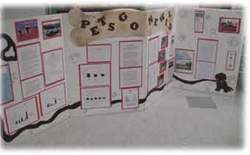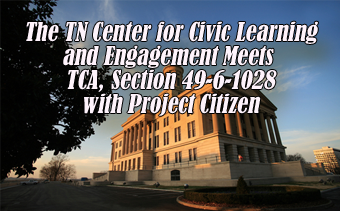Project Citizen

Introduction
We the People: Project Citizen is a curricular program for middle, secondary, and post-secondary students, youth organizations, and adult groups that promotes competent and responsible participation in local and state government. The program helps participants learn how to monitor and influence public policy. In the process, they develop support for democratic values and principles, tolerance, and feelings of political efficacy
Entire classes of students or members of youth or adult organizations work cooperatively to identify a public policy problem in their community. They then research the problem, evaluate alternative solutions, develop their own solution in the form of a public policy, and create a political action plan to enlist local or state authorities to adopt their proposed policy. Participants develop a portfolio of their work and present their project in a public hearing showcase before a panel of civic-minded community members.The Project Citizen program is administered with the assistance of a national network of state and congressional district coordinators in every state and is conducted with the assistance of the National Conference of State Legislatures. It is funded by the U.S. Department of Education by act of Congress. Additional funding at the state level is also provided by an increasing number of state legislatures. Program Participation
The curriculum was first used in the 1995-96 school year as a pilot in 12 states. Since then the domestic program has expanded to include schools in every state as well as American Samoa, the District of Columbia, Guam and Puerto Rico. As of November 2006, approximately 22,500 teachers have taught Project Citizen to over 1,400,000 students.
The formula for tracking student participation is based on two different surveys. The first was conducted in November 1997 by researchers at the Lyndon B. Johnson School of Public Affairs, University of Texas at Austin, in preparing An Assessment of We the People Project Citizen: Promoting Citizenship in Classrooms and Communities. The second was conducted by the Center for Civic Education in February 1999.
What is Public Policy?Getting scholars to agree on a single, all-inclusive definition of public policy is no easy task.Broadly, we might say that a public policy is simply what government (any public official who influences or determines public policy, including school officials, city council members, county supervisors, etc.) does or does not do about a problem that comes before them for consideration and possible action.
Specifically, public policy has a number of key attributes:
- Policy is made in response to some sort of issue or problem that requires attention. Policy is what the government chooses to do (actual) or not do (implied) about a particular issue or problem.
- Policy might take the form of law, or regulation, or the set of all the laws and regulations that govern a particular issue or problem.
- Policy is made on behalf of the "public."
- Policy is oriented toward a goal or desired state, such as the solution of a problem.
- Policy is ultimately made by governments, even if the ideas come from outside government or through the interaction of government and the public.
- Policymaking is part of an ongoing process that does not always have a clear beginning or end, since decisions about who will benefit from policies and who will bear any burden resulting from the policy are continually reassessed, revisited and revised.
Public policy problems are those that must be addressed by laws and regulations adopted by government. Your first task in ProCitizen is to firmly establish that the problem you want to work on is, in fact, one which requires government involvement to reach a solution.
Note: This material is adapted from An Introduction to the Policy Process, by Thomas A. Birkland (2011, M.E. Sharpe, Armonk, NY)
|
Project Citizen Overview PowerPoint
Center for Civic Education |
| ||||||
|
Effective Citizenship Activity
Center for Civic Education |
| ||||||
|
Correlation-Reading
Center for Civic Education |
| ||||||
|
Correlation-Writing
Center for Civic Education |
| ||||||
|
Correlation-Service Learning
Center for Civic Education |
| ||||||
What is Public Policy and Who Makes it?
General Public Policy Issues Research from Vanderbilt University (Weblink)
Public Policy and Levels of Government PPT from iCivics.org (PowerPoint)
ABC's of County Government (PDF)
Faces of Government (PDF)
Who's Job is it Anyway Activity Classroom Activity (Word Doc)
Literature Connections (Word Doc)
Sample issues (Word Doc)
Project Citizen Children Literate Connection (Word Doc)
Nursery Rhyme Assignment (Word Doc)
Nursery Rhyme List (Word Doc)
Nursery Rhymes Example (Erin Crowe) (PDF)
Project Cinema (Erin Crowe) (PDF)
What's the Story Activity (Erin Crowe) (PDF)
Linking the Problem (Erin Crowe) (PDF)
Completed Class example (Doc)
Public Policy Issue or Not Activity Assignment (Word Doc)
Public Policy Issue or Not Activity T-Chart Assignment (Word Doc)
Public Policy Worksheet Assignment (Word Doc)
Public Policy Article: Public Policy: Facts, Myths, and Values Jerri Cockrel, Extension Public Policy Specialist (PDF)
Public Policy Article: Public Policy: Making in America Jerri Cockrel, Extension Public Policy Specialist (PDF)
Public Policy Defined (Word Doc)
Literature Connection Barbara Ashby- Rhode Island (PDF)
Public Policy and Levels of Government PPT from iCivics.org (PowerPoint)
ABC's of County Government (PDF)
Faces of Government (PDF)
Who's Job is it Anyway Activity Classroom Activity (Word Doc)
Literature Connections (Word Doc)
Sample issues (Word Doc)
Project Citizen Children Literate Connection (Word Doc)
Nursery Rhyme Assignment (Word Doc)
Nursery Rhyme List (Word Doc)
Nursery Rhymes Example (Erin Crowe) (PDF)
Project Cinema (Erin Crowe) (PDF)
What's the Story Activity (Erin Crowe) (PDF)
Linking the Problem (Erin Crowe) (PDF)
Completed Class example (Doc)
Public Policy Issue or Not Activity Assignment (Word Doc)
Public Policy Issue or Not Activity T-Chart Assignment (Word Doc)
Public Policy Worksheet Assignment (Word Doc)
Public Policy Article: Public Policy: Facts, Myths, and Values Jerri Cockrel, Extension Public Policy Specialist (PDF)
Public Policy Article: Public Policy: Making in America Jerri Cockrel, Extension Public Policy Specialist (PDF)
Public Policy Defined (Word Doc)
Literature Connection Barbara Ashby- Rhode Island (PDF)
Step 1: Identifying Public Policy Problems in Your Community
Step 1 Activity Center for Civic Education (Word Doc)
Is it Public Policy Worksheet Terri Bramhall (Word Doc)
Is it Public Policy Possible Answers Terri Bramhall (Word Doc)
Is it Public Policy or Not Activity Terri Bramhall (Word Doc)
Is it Public Policy Worksheet Terri Bramhall (Word Doc)
Is it Public Policy Possible Answers Terri Bramhall (Word Doc)
Is it Public Policy or Not Activity Terri Bramhall (Word Doc)
Step 2: Selecting a Problem for Class Study
Decision Making Matrix Terri Bramhall (Word Doc)
Problem Analysis Form Terri Bramhall (PDF)
Explaining the Problem Terri Bramhall (PDF)
Class Problem Terri Bramhall (Word Doc)
Constitutional Form Terri Bramhall (PDF)
Problem Analysis Form Terri Bramhall (PDF)
Explaining the Problem Terri Bramhall (PDF)
Class Problem Terri Bramhall (Word Doc)
Constitutional Form Terri Bramhall (PDF)
Step 3: Gathering Information on the Problem Your Class Will Study
Daily Worksheet Terri Bramhall (Word Doc)
Interview Forms Terri Bramhall (PDF)
Media Form Terri Bramhall (PDF)
Printed Source Guide Terri Bramhall (PDF)
Resource Handout Center for Civic Education (Word Doc)
Understanding Special Interest Groups Center for Civic Education (Word Doc)
Free Survey Taking Resource (Weblink)
Making Easy Online Graphs National Center for Education Statistics (Weblink)
Interview Forms Terri Bramhall (PDF)
Media Form Terri Bramhall (PDF)
Printed Source Guide Terri Bramhall (PDF)
Resource Handout Center for Civic Education (Word Doc)
Understanding Special Interest Groups Center for Civic Education (Word Doc)
Free Survey Taking Resource (Weblink)
Making Easy Online Graphs National Center for Education Statistics (Weblink)
Step 4: Developing a Class Portfolio
Panel 1 Form Terri Bramhall (Word Doc)
Panel 2 Form Terri Bramhall (Word Doc)
Panel 3 Form Terri Bramhall (Word Doc)
Panel 4 Form Terri Bramhall (Word Doc)
Panel 1 Detailed Form Terri Bramhall (Word Doc)
Panel 2 Detailed Form Terri Bramhall (Word Doc)
Panel 3 Detailed Form Terri Bramhall (Word Doc)
Panel 4 Detailed Form Terri Bramhall (Word Doc)
Constitutional Opinion Form (Word Doc)
Examining Alternative Policies Center for Civic Education (PDF)
PC Problem and Alternatives Center for Civic Education (PDF)
Developing an Action Plan Center for Civic Education (PDF)
Panel 2 Form Terri Bramhall (Word Doc)
Panel 3 Form Terri Bramhall (Word Doc)
Panel 4 Form Terri Bramhall (Word Doc)
Panel 1 Detailed Form Terri Bramhall (Word Doc)
Panel 2 Detailed Form Terri Bramhall (Word Doc)
Panel 3 Detailed Form Terri Bramhall (Word Doc)
Panel 4 Detailed Form Terri Bramhall (Word Doc)
Constitutional Opinion Form (Word Doc)
Examining Alternative Policies Center for Civic Education (PDF)
PC Problem and Alternatives Center for Civic Education (PDF)
Developing an Action Plan Center for Civic Education (PDF)
Step 5: Presenting Your Portfolio
PC Binder/Portfolio Grade Sheet Terri Bramhall (Excel Doc)
High School PC PPT Grade Sheet Terri Bramhall (Excel Doc)
Project Evaluation Sample Form Terri Bramhall (Word Doc)
Over All Portfolio Criteria Terri Bramhall (Word Doc)
Project Evaluation Guidelines Center for Civic Education (PDF)
Project Evaluation Checklist Center for Civic Education (PDF)
High School PC PPT Grade Sheet Terri Bramhall (Excel Doc)
Project Evaluation Sample Form Terri Bramhall (Word Doc)
Over All Portfolio Criteria Terri Bramhall (Word Doc)
Project Evaluation Guidelines Center for Civic Education (PDF)
Project Evaluation Checklist Center for Civic Education (PDF)


